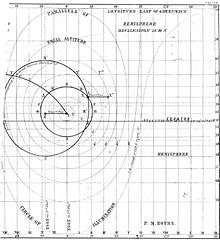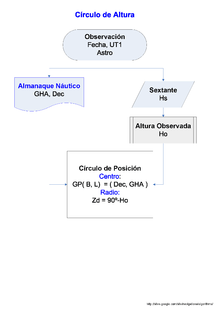Circle of equal altitude
The circle of equal altitude also called circle of position, CoP, is the real line of position in celestial navigation. It is defined as the locus of points on the Earth on which an observer sees a star, at a given time, with the same observed altitude. It was discovered by the American sea-captain Thomas Hubbard Sumner.

Parameters

The center of the CoP, is the substellar point or geographical position of the observed body, and its radius is the great circle distance equal to the zenith distance of the body.
- Center = geographical position of the body: (B, L) = (Dec, GHA)
- Radius = zenith distance: zd [nm] = 60 ⋅ (90 - Ho)
Equation
The equation links the following variables[1]
- The position of the observer: B, L.
- The coordinates of the observed star, its geographical position: GHA, Dec.
- The true altitude of the body: Ho.
Being B the latitude (+N/S), L the longitude (+E/-W). LHA = GHA + L is the local hour angle, Dec and GHA are the declination and Greenwich hour angle of the star observed. And Ho is the true or observed altitude, that is, the altitude measured with a sextant corrected for dip, refraction and parallax.
Special cases
- Parallel of latitude by Polaris altitude.
- Parallel of latitude by altitude of the sun at noon, or meridian altitude.
- Meridian of longitude known the time and latitude.
- Circle of illumination or terminator
References
External links
- Navigational Algorithms http://sites.google.com/site/navigationalalgorithms/
- Correction to the sextant altitude Archivo:CorrecionHs.jpg